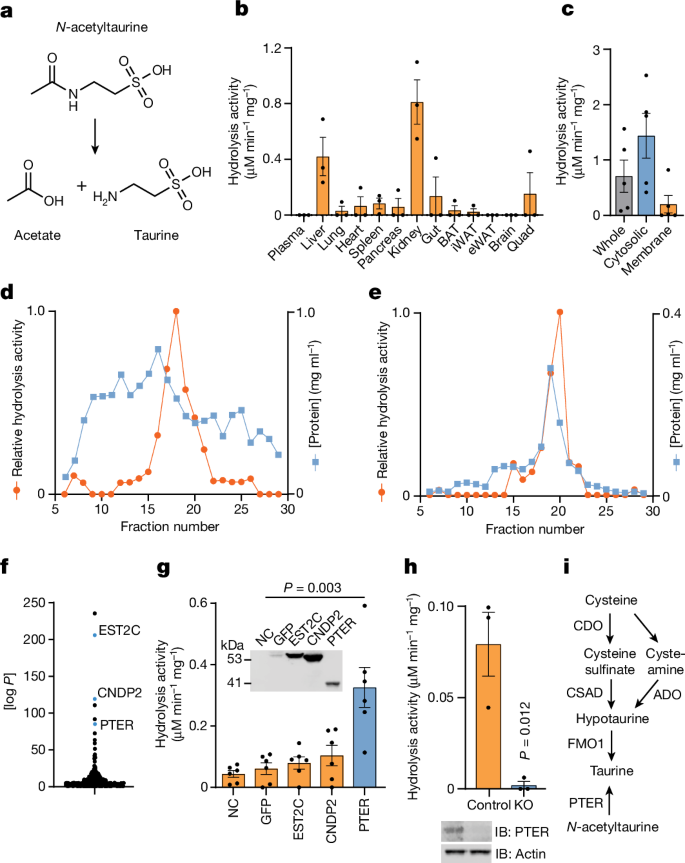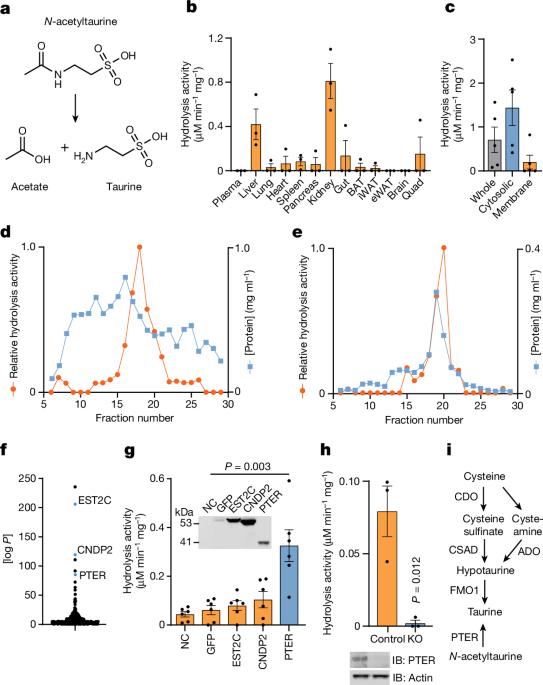PTER is a N-acetyltaurine hydrolase that regulates feeding and obesity
IF 50.5
1区 综合性期刊
Q1 MULTIDISCIPLINARY SCIENCES
引用次数: 0
Abstract
Taurine is a conditionally essential micronutrient and one of the most abundant amino acids in humans1–3. In endogenous taurine metabolism, dedicated enzymes are involved in the biosynthesis of taurine from cysteine and in the downstream metabolism of secondary taurine metabolites4,5. One taurine metabolite is N-acetyltaurine6. Levels of N-acetyltaurine are dynamically regulated by stimuli that alter taurine or acetate flux, including endurance exercise7, dietary taurine supplementation8 and alcohol consumption6,9. So far, the identities of the enzymes involved in N-acetyltaurine metabolism, and the potential functions of N-acetyltaurine itself, have remained unknown. Here we show that the body mass index associated orphan enzyme phosphotriesterase-related (PTER)10 is a physiological N-acetyltaurine hydrolase. In vitro, PTER catalyses the hydrolysis of N-acetyltaurine to taurine and acetate. In mice, PTER is expressed in the kidney, liver and brainstem. Genetic ablation of Pter in mice results in complete loss of tissue N-acetyltaurine hydrolysis activity and a systemic increase in N-acetyltaurine levels. After stimuli that increase taurine levels, Pter knockout mice exhibit reduced food intake, resistance to diet-induced obesity and improved glucose homeostasis. Administration of N-acetyltaurine to obese wild-type mice also reduces food intake and body weight in a GFRAL-dependent manner. These data place PTER into a central enzymatic node of secondary taurine metabolism and uncover a role for PTER and N-acetyltaurine in body weight control and energy balance. The orphan enzyme phosphotriesterase-related (PTER) is identified as a mammalian N-acetyltaurine hydrolase that has roles in regulating body weight and energy balance.


PTER 是一种调节进食和肥胖的 N-乙酰胞嘧啶水解酶。
牛磺酸是一种条件性必需微量营养素,也是人体中含量最高的氨基酸之一1-3。在内源性牛磺酸代谢过程中,专门的酶参与了牛磺酸与半胱氨酸的生物合成以及次级牛磺酸代谢产物的下游代谢4,5。牛磺酸代谢物之一是 N-乙酰牛磺酸6。N-acetyltaurine 的水平受改变牛磺酸或醋酸通量的刺激因素的动态调节,包括耐力运动7 、膳食牛磺酸补充8 和饮酒6,9。迄今为止,参与 N-乙酰基牛磺酸代谢的酶的身份以及 N-乙酰基牛磺酸本身的潜在功能仍然未知。在这里,我们发现与身体质量指数相关的孤儿酶磷酯酶(PTER)10 是一种生理性的 N-乙酰牛磺酸水解酶。在体外,PTER 催化 N-乙酰基牛磺酸水解为牛磺酸和乙酸。在小鼠体内,PTER 在肾、肝和脑干中表达。小鼠 PTER 的基因消减会导致组织完全丧失 N-乙酰基牛磺酸水解活性,并导致全身 N-乙酰基牛磺酸水平升高。在受到增加牛磺酸水平的刺激后,Pter 基因敲除小鼠的食物摄入量会减少,对饮食引起的肥胖具有抵抗力,葡萄糖稳态也会得到改善。给肥胖的野生型小鼠注射 N-乙酰牛磺酸也会以依赖 GFRAL 的方式减少食物摄入量和体重。这些数据将 PTER 置于次级牛磺酸代谢的中心酶节点,并揭示了 PTER 和 N-乙酰牛磺酸在体重控制和能量平衡中的作用。
本文章由计算机程序翻译,如有差异,请以英文原文为准。
求助全文
约1分钟内获得全文
求助全文
来源期刊

Nature
综合性期刊-综合性期刊
CiteScore
90.00
自引率
1.20%
发文量
3652
审稿时长
3 months
期刊介绍:
Nature is a prestigious international journal that publishes peer-reviewed research in various scientific and technological fields. The selection of articles is based on criteria such as originality, importance, interdisciplinary relevance, timeliness, accessibility, elegance, and surprising conclusions. In addition to showcasing significant scientific advances, Nature delivers rapid, authoritative, insightful news, and interpretation of current and upcoming trends impacting science, scientists, and the broader public. The journal serves a dual purpose: firstly, to promptly share noteworthy scientific advances and foster discussions among scientists, and secondly, to ensure the swift dissemination of scientific results globally, emphasizing their significance for knowledge, culture, and daily life.
 求助内容:
求助内容: 应助结果提醒方式:
应助结果提醒方式:


